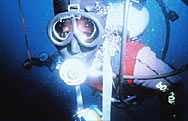March 14, 2000
Chuck Amsler
[Editors Note: In Part One Chuck Amsler described the events leading up to the UAB in Antarctica teamís dive along a vertical wall about 30 feet from the rocky south shore of Janus Island. Before entering the water, they devised a new diver-to-diver hand signal to warn each other of the approach of dangerous leopard seals. Chuck and Palmer Station boating coordinator Ross Hein then descended to about 100 feet and began collecting macroalgae during a gradual ascent.]
When Ross and I got up to 55 feet on the Janus Island wall, much as we didn't want to leave it was time to head up into shallow water for our safety stops. All the diving we do is "no-decompression," meaning that the dive tables our underwater computers are using as they monitor our dives say that it is safe for us to make a direct ascent to the surface at any time. There is no requirement to make decompression stops on the way up in order to prevent the bends.
However, just to be safe, after deep dives we make stops anyway, usually at 20 and 10 feet.
We passed Katrin and Bill at about 35 feet as they were beginning their dive down the wall. My large collecting bag was clipped off to a rope on my dive vest and floating just above me, full of a large (each 10 to 15 feet long) brown macroalga that grows in 70 to 120 feet or more of water but buoys itself up with gas-filled floats. We needed to find this species with reproductive structures and the search for it has been my No. 1 priority for the last few days. That priority is now taken care of!
By the time we got back up to the ledge area at 30 feet the current was ripping along the shore again, and by 25 feet the surge from waves above us was moving us back and forth quite forcefully. We had to work exceptionally hard to hold our horizontal position in the water at the first stop.
Soon after we got there, a large seal moved into view just above me. The first thought when that happens here is "is it a leopard?" But I quickly saw that it was one of five or six large crabeater seals. S/he was about five feet from me and the others about 15 feet away. Although not aggressive, these animals are much more massive than a diver, and so they are one of the last things we wanted to have that close to us in the high-wave energy environment we were in.
To be safe, we dropped down to a ledge at 25 feet until their curiosity with us ended and they moved on. When they'd gone we worked our way up to about 15 feet, where we could hold on to macroalgae and the edges of boulders to help keep our horizontal position along the shore and then, finally, we moved up to a mid-water safety stop at about 10 feet for a couple minutes as we drifted down current.
When we broke the surface, Jim and Joanna were watching for us from a safe distance of about 70 to 90 yards away. They quickly moved the boat to pick us up as we swam out and away from the steep rocky shore. Getting one's self and 90 or so pounds of dive gear up over the rubber Zodiac boat pontoons requires a few tricks. The tricks let you do it by yourself if all goes well. We'll save that for a future journal entry.
Once in the boat, Ross and I took off our masks, dry gloves, and fins while spewing non-stop superlatives about the dive. We then realized that the fog had broken and left a crystal clear, cloudless sky and spectacular views of the glaciers and mountains of Anvers Island -- two peaks of about 5000 feet and another of about 10,000 feet, all rising up from sea level -- as well as the black ridge line of Wiencke Island and all the smaller islands around Palmer. An absolutely stunning panorama of blue sky, black rocks, white snow, blue ice, and shimmering water. Ross and I had departed from a dazzling underwater wonderland and ascended into a very different but nonetheless marvelous one in the air.
Suddenly, before they were due back on the surface, we saw Katrin and Bill up against the shore trying desperately to climb through the surf onto the steep rocks. And then we saw the leopard seal.
-- To be continued...


